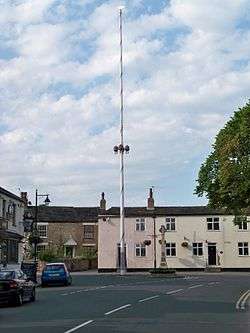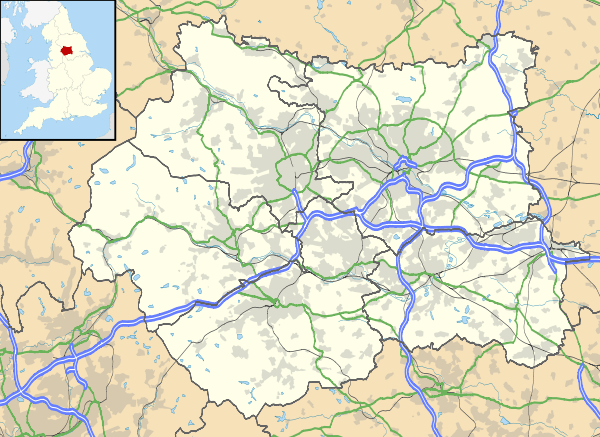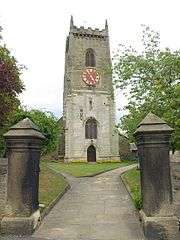Barwick-in-Elmet
Coordinates: 53°49′52″N 1°23′40″W / 53.831152°N 1.394488°W
Barwick-in-Elmet is a village in West Yorkshire, 7 miles (11 km) east of Leeds city centre. It is one of only three places in the area to be explicitly associated with the ancient Celtic kingdom of Elmet, the others being Scholes-in-Elmet and Sherburn-in-Elmet. It is part of the civil parish of Barwick in Elmet and Scholes. The name Barwick comes form the Old English for "barley wick", and was recorded in the Domesday Book of 1086 as Bereuuith.[1]
History
Barwick dates back to between 200-600 BC. There are major Iron Age and Norman earthworks in the centre of the village called Wendel Hill and Hall Tower Hill. There is reference to an agricultural settlement in the Domesday Book of 1086. From a taxation survey, it is known that in 1379 there were 197 adults living in about 100 households.
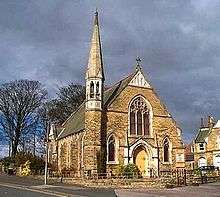
.
For some time the Manor of Barwick and Scholes was in the ownership of the Gascoigne family of Parlington and Lotherton.
In 1720 the first known school in Barwick in Elmet opened. By 1821 the parish had a population of 1,481.
The Cross Gates to Wetherby railway line opened in 1874, with a station in nearby Scholes, enabling residents to commute to Leeds city centre. This service remained running until 1965, when the line closed under the Beeching Axe.
Throughout the 20th century the village grew with many modern houses being built in and around the village by both private developers and the local corporations. During this period many of the older cottages in the village centre were converted into shops and other small business premises.
For much of its history the village supported a mainly agricultural community. From the late 17th century until the early 20th century many residents were employed in the local mining industry in Garforth, Cross Gates and Whitkirk. Today, whilst still having a rural agricultural feel, the village supports many trades as well as housing for people who work in Leeds and York.
Barwick iron age fort
The village includes earthworks created as an Iron Age fort, and used later as the site of a Norman Motte and Bailey castle and later as a Second World War observation post.[2] The land is currently under multiple ownership, which causes problems for its conservation. Ex-local MP Colin Burgon made it the subject of an Adjournment Debate in the House of Commons on 10 July 2007,[3] and Minister of State for the Department for Culture, Media and Sport, Margaret Hodge, replied.[4]
Governance
Barwick-in-Elmet comes under the civil parish of Barwick and Scholes. This comes under the governance of Leeds City Council. Barwick lies within the parliamentary constituency of Elmet and Rothwell which since May 2010 has been held by the Conservative MP, Alec Shelbrooke.
Maypole
One of the most notable village landmarks is the wooden maypole 86 feet (26 m) high that stands at the junction of Main Street and the Cross. The triennial maypole festival (held on Spring Bank Holiday) typically brings large crowds to the area. Every three years, the maypole is lowered, inspected, maintained and re-erected. The festival celebrations include a procession (involving floats decorated by local organisations), children's maypole dancing, morris dancing, a street craft market, and the raising of the maypole ceremony. Traditionally the maypole was lowered and raised manually using an intricate system of ropes and ladders.[5][6] Although methods have changed in recent years, the maypole is still carried by hand from Hall Tower Hill to the heart of the village. During the raising ceremony, it is tradition for a local villager to climb halfway up the pole to disconnect the guide ropes. The climber is then spurred on by a large crowd to climb all the way to the top of the pole, to spin 'the fox' weather vane (a custom thought to bring good luck to the village). The last maypole festival took place on 26 May 2014, and the next festival is scheduled to take place in May 2017.[7][8][9]
Amenities
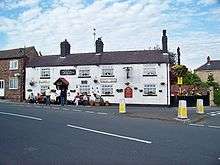
Barwick has three public houses, the New Inn, the Black Swan and the Gascoigne Arms. There are two general stores (the larger one with a post office); a fish and chip shop; an Italian takeaway; a bicycle store; a florist's, baker's, hair & beauty salon and a car mechanics. There are two small churches, one Church of England and one Methodist. There are further amenities in nearby Garforth, Cross Gates, Seacroft and Wetherby, all of which have supermarkets. There are nearby secondary schools in Pendas Fields, Garforth, Seacroft, Boston Spa and Wetherby.
Places of worship
Barwick parish church is a grade II* listed building. It includes Anglo-Saxon and Norman stonework, with a 14th-century chancel and various later additions and alterations.[10][11]
The Unitarian minister Newcome Cappe was married here on 19 February 1788 on his second marriage to Catherine Cappe.(, p.,246)
Local media
The local newspaper is the Wetherby News whilst the regional newspaper is the Yorkshire Evening Post. The local BBC radio station is BBC Radio Leeds, whilst there are many other independent local radio stations in the area. There are cinemas nearby in Leeds, Wetherby and Castleford.
Barwick in popular culture
The theme tune to The Archers is called "Barwick Green". It was written by Yorkshire composer Arthur Wood in 1924, as a "maypole dance" in his suite My native heath. The other items in this suite are "Ilkley Tarn", "Bolton Abbey" and "Knaresborough Status".[12]
Widge, the protagonist in The Shakespeare Stealer, a 1998 young adult novel by Gary Blackwood, is from Barwick-in-Elmet.
Other Barwicks
There are other villages in England called Barwick in Norfolk and Somerset, and a suburb of Stockton-on-Tees is called Ingleby Barwick. There is a town called Barwick in Georgia in the USA.
Comparison
Barwick lies in the LS15 postcode area. Here is a population breakdown of the postcode area in comparison with the UK population.
| Category | LS15 | UK average |
|---|---|---|
| Population density (people / sq mi) | 43.2 | 24.9 |
| Gender split (females / male) | 1.05 | 1.05 |
| Average commute | 6.1 miles | 8.73 miles |
| Average age | 38 | 39 |
| Home ownership | 16% | 16.9% |
| Student population | 2.4% | 4.4% |
| People in good health | 69% | 69% |
Location grid
 |
Potterton |  | ||
| Scholes | |
Aberford | ||
| ||||
| | ||||
| Garforth |
References
- ↑ Hanks, Patrick; Hodges, Flavia; Mills, A. D.; Room, Adrian (2002). The Oxford Names Companion. Oxford: the University Press. p. 937. ISBN 0198605617.
- ↑ Historic England. "Barwick in Elmet hillfort and motte and bailey castle (52862)". PastScape. Retrieved 6 October 2016.
- ↑ "Hansard". 10 July 2007. pp. col.1421–1424. Retrieved 29 June 2008.
- ↑ "Hansard". 10 July 2007. pp. col. 1424–1425. Retrieved 29 June 2008.
- ↑ "Raising and Lowering the Maypole". Barwick-In-Elmet Historical Society. March 1987. Retrieved 7 December 2015.
- ↑ Leeds Cine Club. "Leeds Movie Makers present the fall and rise of the barwick maypole (film no: 1485)". Yorkshire Film Archive. Retrieved 24 November 2016.
- ↑ "Barwick-in-Elmet Maypole Trust". Barwick-in-Elmet Maypole Trust Committee. Retrieved 2 June 2014.
Barwick Maypole Festival Monday 26th May 2014 ... Join us for the triennial Maypole Festival
- ↑ Berry, Chris (25 April 2008). "Tradition in pole position at Barwick". Yorkshire Post. Archived from the original on 12 May 2008. Retrieved 26 June 2008.
- ↑ "Crowds attracted to Barwick-in-Elmet maypole ceremony". 28 May 2008. Retrieved 26 June 2008.
- ↑ Historic England. "Church of All Saints, Barwick (342143)". Images of England. Retrieved 24 March 2011.
- ↑ "Note on the Parish Church etc". Barwick Historical Society. Retrieved 24 March 2011.
- ↑ Scowcroft, Philip L. "A Yorkshire Musician - Arthur Wood (1875-1953)". Retrieved 26 June 2008.
Further reading
- Bantoft, Arthur (1992). A Greater Wonder: a History of Methodism in Barwick. Wendel Books. ISBN 0-9520572-0-4.
External links
 Media related to Barwick-in-Elmet at Wikimedia Commons
Media related to Barwick-in-Elmet at Wikimedia Commons- Leeds City Council
- Barwick-in-Elmet and Scholes Parish Council
- Barwick-in-Elmet Historical Society
- Barwick-in-Elmet Maypole Trust
- Barwick Tennis Club
- The Gascoigne Arms
- The ancient parish of Barwick in Elmet: historical and genealogical information at GENUKI.
- Barwick [in Elmet] in the Domesday Book
